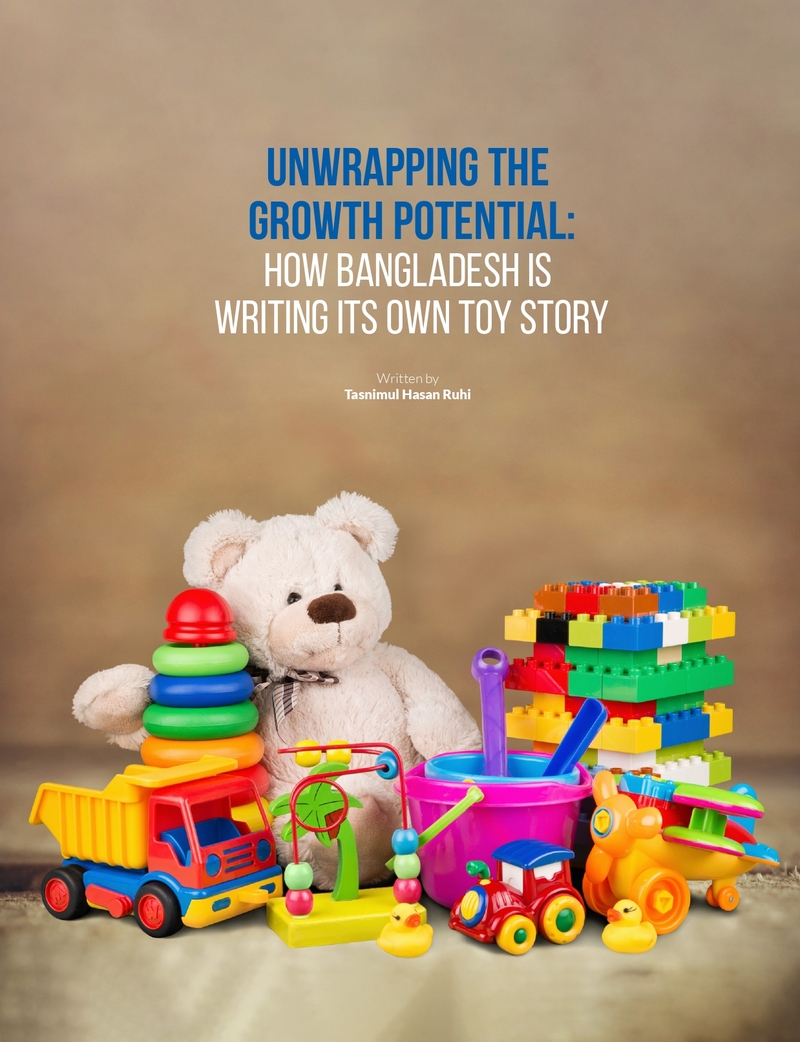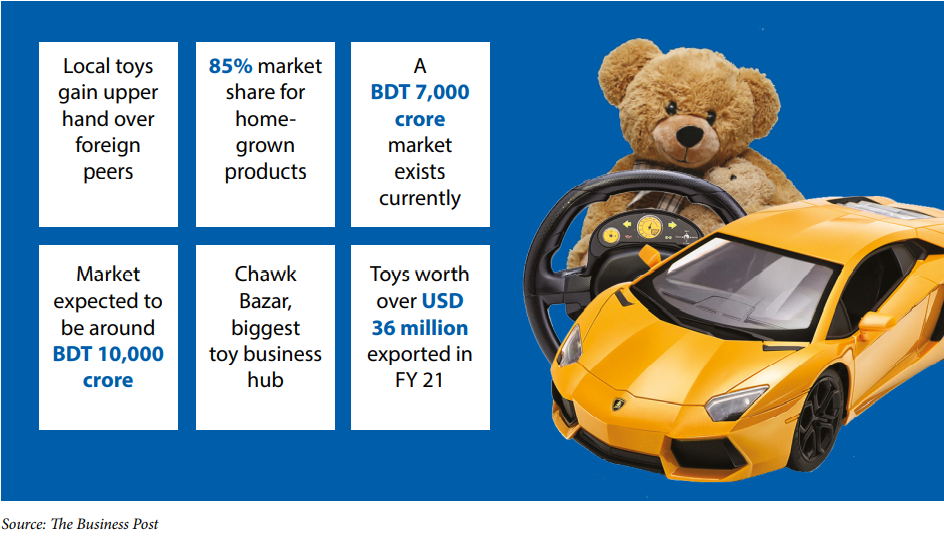
Unwrapping the Growth Potential: How Bangladesh Is Writing Its Own Toy Story
Tasnimul Hasan Ruhi
It is a rare sight to see children without some kind of toy when they are out and about. They grow an emotional connection with the inanimate object, which instils moments of joy while playing with it. But toys are more than just objects of amusement; they are important teaching tools that can shape the way a child develops and grows emotionally and intellectually. It gives children the opportunity to explore and express themselves, as well as develop their creativity and problem-solving skills. Bangladesh is home to a thriving toy industry which has been bringing smiles on children’s faces since 1998. The vibrant and intricate toy designs are a reflection of the country’s bright and lively culture. Almost 1.50 million workers are employed in more than 5,000 plastic companies spread across the country (UNB News, 2022). These plastic companies are the major manufacturers of toys which are available throughout the local shops and bazaars. The expected revenue of this industry was USD 157 million in 2022, which is a 16% increase over the previous year and a CAGR of 19.65% (Statista, 2022).
Market Scenario
The toy industry is a dynamic and ever changing sector of the consumer goods market. With an estimated value of USD 129.45 billion in 2020, it is one of the largest markets in the world (Fortune Business Insight, 2021). Disney, Hasbro, Mattel, and Lego are some of the prominent names in the toy industry. From classic wooden toys to the latest high-tech gadgets, they produce their toys based on pop culture events and idols. Through constant innovation, these companies have been able to keep up with changing consumer preferences, making them attractive brands for many children. Bangladesh has contributed to this industry by offering highly affordable toys with quality comparable to the toy manufacturers of other countries. The toy manufacturing hub is located at Chawkbazar near Lalbagh Fort in Old Dhaka, where thousands of toys are produced and sold every day. It is home to more than 500 wholesale toy sellers. Through these shops, toys are distributed throughout the whole nation. These local toys are made mostly from plastics, while others are made from fabrics, paper and other materials.

Growth Prospects
The growth of the toy industry is a natural phenomenon in a country like Bangladesh. According to UNICEF, there are about 64 million children, and they comprise 40% of the total population (UNICEF, 2022). So, there is an ever-increasing demand for toys which are met by local producers and importers. Granted, all of them are not equally opportune to enjoy the imported toys, Bangladeshi industry is excelling at producing cheap alternatives of otherwise expensive products. Toys as cheap as BDT 10 are available in the local bazar, which gives even the underprivileged kids a chance to enjoy their childhood. This, in turn, pulls up the demand and supply of locally produced toys. The toy industry in Bangladesh has seen remarkable growth in recent years, with an estimated market size of over USD 385.50 million by 2027 (Statista, 2022). In 2022, the demand from customers was around BDT 7,000 crore, and the local manufacturers matched a stunning BDT 4,000 crore of that total demand (The Business Post, 2022). Toys that were manufactured in Bangladesh have already been sent to both Europe and North America, where there is an ever-increasing demand for these products. Bangladeshi workers have been able to successfully combine traditional craftsmanship with modern manufacturing techniques. As a result, the toys produced in Bangladesh are of high quality, affordable, and highly sought after in both international and local markets. This has allowed the industry to expand and grow, providing numerous economic benefits to its workers and helping to stimulate the country’s economy. “Bangladesh may become the world’s 28th biggest exporter of toys if the present growth rate continues,” said Md Jashim Uddin, President of the Federation of Bangladesh Chambers of Commerce and Industry (Business Inspection, 2022). With the increasing demand, more and more toy companies are entering the market, which has helped us meet local demands and also have a surplus for exports. But this was not the scene even a decade ago, as most of the toys were imported from countries like China. Regarding this, Shamim Ahmed, president of the BPGMEA, said that approximately 90% of the toys in Bangladesh were imported ten years ago; now, barely 10% are imported (The Daily Star, 2022). He also added that this labour-intensive industry offers a huge number of job opportunities and will undoubtedly play a crucial part in the future success of the country’s exports.
Roadblocks
Even though the industry shows a promising future, there are some blockades which are hampering its growth. Tackling these problems can give us an industry which can contribute substantially to our total export earnings. Globally, the rise of the video game industry has diverted children’s attention from toys which are making the future of the industry seem bleak. The market size of the global video game industry in 2021 was USD 195.65 billion, which is much higher than the global toy industry (Grand View Research, 2022). Because children can play any kind of game if they have access to a smartphone or computer, they prefer having the choices it offers. This also reduces the cost parents have to bear to entertain their kids. Even when parents want toys, they opt for educational toys rather than something which provides mindless entertainment. The decreasing birth rate is also a major threat to the industry. Over the course of the last seven decades, fertility rates have dropped all over the globe by a combined total of fifty per cent (World Economic Forum, 2022). This is due to the high cost of raising children, women’s empowerment in education and the workforce etc. With fewer children being born, there is less need for these products in the marketplace. This has caused a dampening of demand, leading to decreased growth and difficulty in staying competitive with other forms of entertainment. On top of these, there are constant pressures from environmental activists about the raw material that are used for the production of toys. When exposed to high temperatures or other environmental conditions, these plastics can break down and release toxins into the air or water, posing a risk to both animals and humans. Most of the toys are made from hard plastic, which is not a bio-degradable component. The discarded toys can accumulate in landfills and in our oceans, posing a threat to both wildlife and the environment. Finally, some plastics used in toys contain hazardous chemicals that can be ingested by children, leading to potential health risks. All these concerns create legal issues which put constraints on the use of plastics and increase the cost of production. This lowers the profit margin and makes it an uninviting industry for people to conduct business. Toy producers are also suffering from the high cost of importing raw materials. According to Shahjahan Mazumder, president of Bangladesh Toy Merchants, Manufacturers and Importers Association, most of the raw materials and machinery are imported from China which forces them to put a high price tag on the toys. The factories also have to hire technicians from China which is really expensive for the businesses to bear. On top of these, lithium-ion batteries and rechargeable batteries are completely dependent on imports from other countries, which increases the overall price of the toys to a certain extent. But these crises can be averted if the raw materials and machinery are produced locally, and better training is provided to the Bangladeshi workers, which will bring the toy industry into the limelight. Other than these, the toy industry of Bangladesh has some issues of its own. These include the impact of the pandemic, government tax on imports, availability of quality raw materials and many more.
Toys during Pandemic
With the advent of the pandemic, lockdowns were imposed all over the country, which disrupted the production and sales of toys. People were focused on products which fulfilled their basic needs, so the thought of buying toys during that time was far-fetched. This caused many entrepreneurs to shut down their businesses, and most of the businesses were forced to cut down on employees. This created a rippling effect, and the industry is still trying to turn around from the disaster.
Government Aid for the Toy Industry
Increasing import tariffs can make customers rely heavily on locally produced toys by reducing their access to imported toys. As consumers become more price-sensitive, they will look for cheaper alternatives, which could lead them to favour locally produced toys that may be better quality or more cost-effective. Additionally, local producers will be incentivized to provide higher quality products at competitive prices, giving customers an incentive to choose locally produced toys. Withdrawing the 10% supplementary duty currently imposed on toy products will help the sector flourish. To further encourage domestic production, the import tariff on imported toys could be raised from USD 7.5 per kilogramme. The toy industry of Bangladesh is booming as it has seen an increase in export opportunities and has developed a range of new products to meet the needs of the global market. The country has established a number of eco-friendly measures to ensure production is conducted sustainably, and there are great opportunities for both large and small producers to take advantage of the growth potential. With this in mind, it is clear that the toy industry of Bangladesh is heading in the right direction and is likely to remain profitable in the future.


Launch of Electric Vehicles in Bangladesh: Hitting the Road to Achieve the Dream of Zero Carbon Footprint
Despite being an integral component of our daily life, transportation accounts for 37% of the world’s carbon dioxide emissions due to its heavy reliance on fossil fuels. However, people are inclined towards electric vehicles (EVs), as reflected in a recent study, which shows EVs account for 8.57% of total automobile sales in 2021 globally, demonstrating the exponential growth potential of the electric vehicle sector.
The electric car industry in Bangladesh is on the rise, as growth of 154% in hybrid car imports from 3,296 units in FY18 to 8,366 units in FY21 has been observed. Increased fuel prices and lower maintenance costs have driven the increase in sales. This adoption has enabled new ventures and start-ups to focus on developing locally manufactured EVs.
Few to no charging hubs, high import duties and misconceptions around the EV currently stand as a roadblock to the bright prospects of this industry. However, it shows promise as the government progresses towards “Vision 2041,” which will enable electric vehicles to run the streets of Bangladesh in full swing.
Md. Shah Jalal
Editor
IDLC Monthly Business Review
Download View